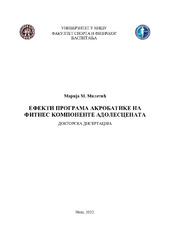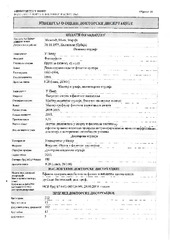Приказ основних података о дисертацији
Efekti programa akrobatike na fitnes komponente adolescenata
| dc.contributor.advisor | Veličković, Saša | |
| dc.contributor.other | Branković, Nataša | |
| dc.contributor.other | Vukašinović, Vladan | |
| dc.contributor.other | Pantelić, Saša | |
| dc.creator | Miletić, Marija | |
| dc.date.accessioned | 2023-02-15T20:35:44Z | |
| dc.date.available | 2023-02-15T20:35:44Z | |
| dc.date.issued | 2022 | |
| dc.identifier.uri | http://eteze.ni.ac.rs/application/showtheses?thesesId=8554 | |
| dc.identifier.uri | https://fedorani.ni.ac.rs/fedora/get/o:1829/bdef:Content/download | |
| dc.identifier.uri | https://plus.cobiss.net/cobiss/sr/sr/bib/68033033 | |
| dc.identifier.uri | https://nardus.mpn.gov.rs/handle/123456789/21179 | |
| dc.description.abstract | The aim of the study was to determine the effects of acrobatics programs on the fitness components of adolescents. The sample of the participants consisted of 50 adolescents, aged (14 years ± 6 months), seventh grade students of the elementary school "Bubanjski heroji" in Niš, divided into two groups: the experimental group and the control group. The experimental group consisted of 25 students, included in the classes of the experimental program of acrobatics (ground floor and skipping), 2 x 45min per week, lasting 32 hours. The control group consisted of 25 students included in the program of regular physical education activities (handball and volleyball) 2 x 45min per week, lasting 32 hours. Measures and tests for the assessment of body composition (5 variables), tests for the assessment of flexibility (3 variable), tests for the assessment of motor fitness (12 variables) were applied to all examinees at the initial and final measurement. At the initial measurement, intergroup differences were found in only two variables. The experimental group achieved statistically significant changes between the initial and final testing in 19 variables. The control group achieved statistically significant changes between the initial and final testing in 15 variables. Using analysis of covariance (MANCOVA/ANCOVA), statistically significant effects were confirmed in 16 variables. The results of the study showed that after an experimental program of acrobatics lasting 16 weeks, the experimental group made statistically significantly greater progress than the control group on all variables that assessed body composition, flexibility and motor fitness except the variable of body weight, which assessed body composition and running variables at 20m from a high start and a jump with a squat without swinging his arms, which assessed motor fitness. Based on the obtained results, it can be concluded that the acrobatics program had positive effects on the transformation of body composition, flexibility and motor fitness of adolescents, more than the program of regular physical education classes. | en |
| dc.format | application/pdf | |
| dc.language | sr | |
| dc.publisher | Универзитет у Нишу, Факултет спорта и физичког васпитања | sr |
| dc.rights | openAccess | en |
| dc.rights.uri | https://creativecommons.org/licenses/by-nc-nd/4.0/ | |
| dc.source | Универзитет у Нишу | sr |
| dc.subject | gimnastika | sr |
| dc.subject | gymnastics | en |
| dc.subject | acrobatics | en |
| dc.subject | elementary school students | en |
| dc.subject | body composition | en |
| dc.subject | flexibility | en |
| dc.subject | motor fitness | en |
| dc.subject | akrobatika | sr |
| dc.subject | učenici osnovne škole | sr |
| dc.subject | telesna kompozicija | sr |
| dc.subject | fleksibilnost | sr |
| dc.subject | motorički fitnes | sr |
| dc.title | Efekti programa akrobatike na fitnes komponente adolescenata | sr |
| dc.type | doctoralThesis | |
| dc.rights.license | BY-NC-ND | |
| dc.identifier.fulltext | http://nardus.mpn.gov.rs/bitstream/id/149429/Miletic_Marija_M.pdf | |
| dc.identifier.fulltext | http://nardus.mpn.gov.rs/bitstream/id/149428/Doctoral_thesis_13221.pdf | |
| dc.identifier.rcub | https://hdl.handle.net/21.15107/rcub_nardus_21179 |



